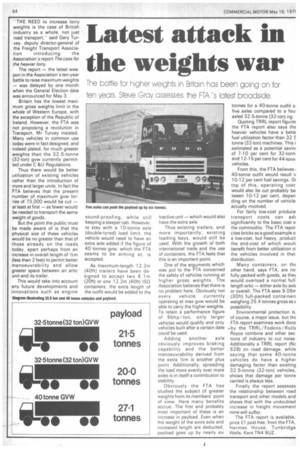Latest attack in the weights war
Page 66

If you've noticed an error in this article please click here to report it so we can fix it.
Inc baffle for higher weights in Britain has been going on for ten years. Steve Gray assesses the FTA "s latest broac side.
THE NEED to increase lorry weights is the case of British industry as a whole, not just road transport,'" said Gary Turvey, deputy director-general of the Freight Transport Associa tion introducing the Association's report The case for the heavier lorry.
The report — the latest weapon in the Association's ten-year battle to raise maximum weights — was delayed by one month when the General Election date was announced for May 3.
Britain has the lowest maximum gross weights limit in the whole of Western Europe, with the exception of the Republic of Ireland. However, the FTA was not proposing a revolution in Transport, Mr Turvey insisted. Many vehicles in common use today were in fact designed, and indeed plated, for much greater weights than the 32.5-tonne (32-ton) gvw currently permitted under C &U Regulations.
Thus there would be better utilization of existing vehicles rather than the introduction of more and larger units. In fact the FTA believes that the present number of maximum gvw lorries of 73,000 would be cut — at least at first — as fewer would be needed to transport the same weight of goods.
But the point the public must be made aware of is that the physical size of these vehicles would be no greater than that of those already on the roads today, apart perhaps from an increase in overall length of 1/2m (less than 2 feet) to permit better manoeuvrability and allow greater space between an artic unit and its trailer.
This would take into account any future developments and innovations such as engine sound-proofing, while still keeping a sleeper cab. However, to stay with a 10-tonne axle (double-tyred) load limit, the vehicle would need to have an extra axle added if the figure of 40 tonnes gvw, which the FTA seems to be aiming at, is accepted.
As maximum-length 12.2m (40ft) trailers have been designed to accept two 6.1m (20ft) or one 12.2m (40ft) ISO containers, the extra length of the outfit would be added to the tractive unit — which would also have the extra axle.
Thus existing trailers, and more importantly, existing loading bays, would still be used. With the growth of both international trade and the use of containers, the FTA feels that this is an important point.
One of the arguments which was put to the FTA concerned the safety of vehicles running at higher gross weights. The Association believes that there is no problem here. Obviously not every vehicle currently operating at max gvw would be able to carry the higher weights. To retain a performance figure of 6bhp /ton, only larger vehicles would qualify and only vehicles built after a certain date could be used.
Adding another axle obviously improves braking capability and the better manoeuvrability derived from the extra 1/2m is another plus point. Additionally, spreading the load more evenly over more axles is in itself a contribution to stability.
Obviously the FTA has studied the subject of greater weights from its members' point of view. Here many benefits accrue. The first and probably most important of these is an increase in payload. Even when the weight of the extra axle and increased length are deducted, payload goes up by nearly six tonnes for a 40-tonne outfit o five axles compared to a foul axled 32.5-tonne (32-ton) rig.
Quoting TR R L report figureE the FTA report also says tha heavier vehicles have a bette fuel utilization factorthan 32.E tonne (32-ton) machines. This i estimated as a potential savini of 7-10 per cent for 32-tonn, and 12-15 per cent for 44-tonn vehicles.
From this, the FTA believes 40-tonne outfit would result ii 10-12 per cent fuel savings. Or top of this, operating cost: would also be cut probably be tween 10-12 per cent, depen ding on the number of vehicle: actually involved.
For fairly low-cost produce transport costs can ad( significantly to the basic cost o the commodity. The FTA repor cites bricks as a good example o a low-cost, but heavy, product the end-cost of which woul( benefit from better utilization ol the vehicles involved in thei distribution.
Many containers, on thE other hand, says FTA, are no fully packed with goods, as the would overload a normal full. length artic — either axle by axIE or overall. The FTA sees 9.05rr (30ft) full-packed containerE weighing 25.4 tonnes gross as E possibility.
Environmental protection is, of course, a major issue, but the FTA report examines work done .by the TRRL/Foclons/ Rolls Royce combine and other sections of industry to cut noise. Additionally a TRRL report (No 628) on road damage, while saying that some 40-tonne vehicles do have a higher damaging factor than existing 32.5-tonne (32-ton) vehicles, shows that damage per tonne carried is always less.
Finally the report assesses the relationship between road transport and other models and shows that with the undoubted increase in freight movement none will suffer.
The FTA report is available, price E1 post free, from the ETA, Hermes House, Tunbridge Wells, Kent TN4 9UZ.




















































































































